As I’ve described in my previous post about the history of the wine pairing dinners that I host, I’ve been organizing wine pairing dinners for 5 years now and I have hosted 25 of them with 11 different themes. To reiterate from the previous post, the cost of food and wine is divided among the guests, and everyone has to help out in some way. Either by coming over to prep in the afternoon, or by helping to serve or clean. This way, we can all enjoy the evening.
In this post, which will be quite long, I will describe how I plan and organize the wine pairing dinners, how I pair the wines, how I prep, and how I serve. All of this so you can have a head start, and know what you are getting into, when you decide to host your own wine pairing dinners. I will try to be as complete as I can, but please feel free to ask any questions.
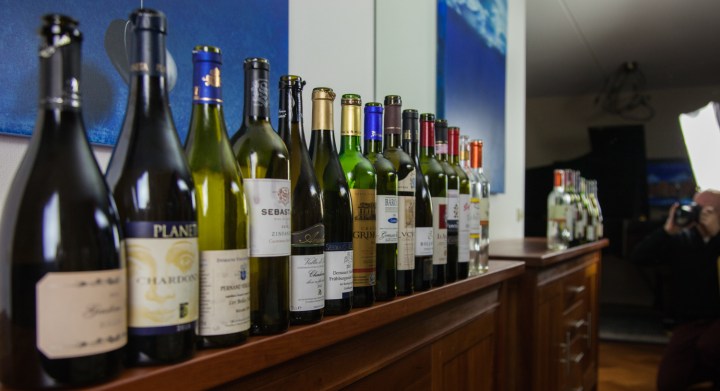
As mentioned in the previous post, most of the photography of prepping and serving is by my friend and blogging buddy Conor who came over from Ireland with ‘the Wife’ to join one of the latest wine pairing dinners. Thank you so much, Conor!
Planning and Organizing
Group size
A wine pairing dinner is about trying different wines with a dish to see how the dish affects the enjoyment of the wine and to see which wine works best with the dish. If you pour carefully, you can pour 16 small glasses out of a regular 75 cl wine bottle. And so for a wine pairing dinner it is best to have a group of between 12 and 16 people, as this allows you to serve two different wines with each course at a reasonable cost. With more than 16, the pours will become too small to be able to taste the wines properly with and without the dish. With less than 12, assuming you finish the bottles, the amount of wine will become too much and also the cost per person will rise.
Number of courses
Since it is a wine pairing dinner, it is nice to taste a substantial number of wines. So serving only three courses with two wines each would perhaps be a bit scant. On the other hand, there should not be too many courses either as it is not the primary intention to get everyone very drunk, the amount of food should not become too large, and it should be manageable to serve all the courses in one evening. And so I have been serving five or six courses, and that has worked very well for me. With this number of courses, there will be 11 or 13 different wines to be tasted (including aperitif), the dinner will last all evening and the amount of food and wine is reasonable.
Additional bottles
Depending on the group size, how thirsty they are and how many will be driving home afterwards, 11 to 13 bottles may not be sufficient. I have developed two solutions for that conundrum.
The first is to have additional bottles ready of all wines that are served, and to open up a second bottle of whichever wine is chosen to be the best match with a course. With 5 courses plus an aperitif, this will bring the total of bottles to 16.
The second is what we’ve started calling a tussenwijntje, an ‘in between’ bottle. This is a wine that is drunk by the guests while the next course is being prepped. It speaks for itself that such a wine should be finished before the wines for the next course will be poured.
The glasses are labeled to make it easy to keep wines #1 and #2 apart.
Time schedule
The time schedule I’ve been using for the evening itself is like this:
17:30 Guests start arriving, aperitif is served
18:00 Course #1
19:00 Course #2
20:00 Course #3
21:00 Course #4
22:00 Course #5
23:00 Course #6 (if there is a sixth course)
If sufficient prepping has been done beforehand (which I will write about more in the paragraph labeled “Prepping”), an hour is enough time to finish the dish, explain the wines, pour the wines, plate the dish, serve the dish, eat the dish, clear away the plates, and wash and dry the plates. This sequence will be repeated five or six times during the evening.
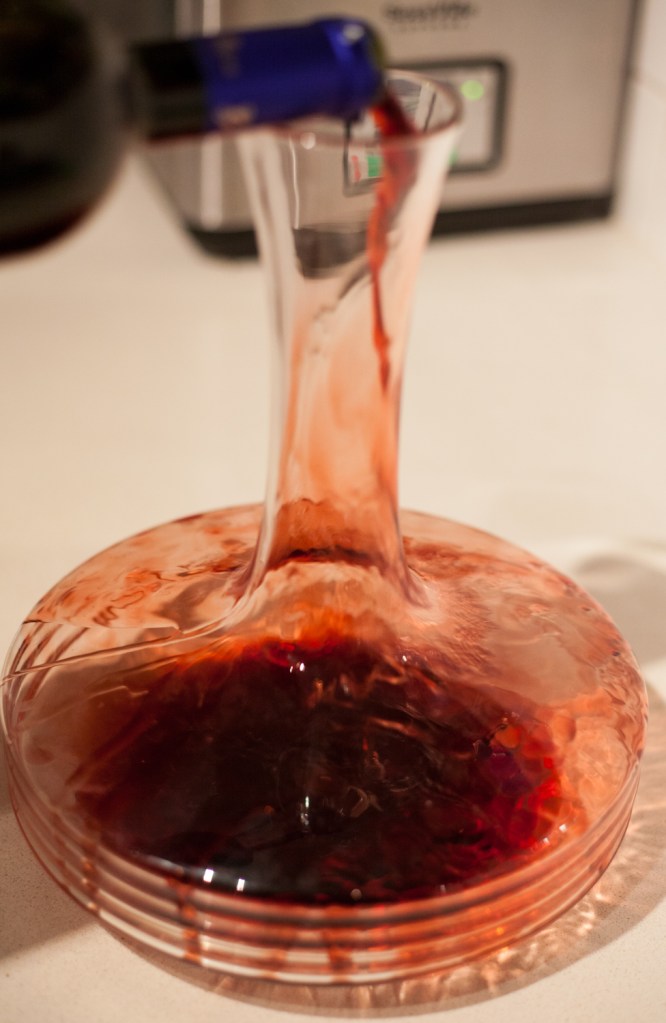
Menu and wines
Choosing a theme
Although not strictly necessary, it is nice to work with a theme. The theme should match with ingredients that are in season. If you have a substantial wine collection you want to source the bottles from, the availability of wines that match the theme is also a good way to pick the theme. As described in the previous post, I have done themes focussing on a certain region with dishes and wines from that region (Burgundy, Piemonte), themes focusing on a certain cuisine (Italian, Asian), or themes focusing on a certain category of dishes (meat, fish, seafood, vegetarian).
Wine pairing
With each dish I will pick two wines that I think are going to work well. I’ve written an introductory post about wine pairing before and I plan to write many more. I provide wine pairing suggestions with many of my recipes. If the wine pairing suggestion says “full bodied white with some oak”, you can pick two wines within that category and be pretty sure that the food and wine will at least go along. When selecting two that are different in some way, e.g. from the same area but different producers, or the same grape variety but different wine regions, it will be nice to compare them and their match with the food. If you are lucky, one of them will be what I call a ‘match made in heaven’. If you host the same dinner more than once, the next time you can adjust the wine selection based on the findings of the first session. In any case, I have learned a lot about wine pairing from hosting these dinners.
Designing a menu
When designing a menu, it is important to think of dishes that will pair with different types of wine. The flavor profile of the dishes, and the flavor profile of the wines that will be paired with them, should be in incremental order. So you start with lighter fresher dishes, and you finish with heavier dishes. Let’s for example have a look at the menu for the ‘Carnivore’ dinner I hosted recently.
First course: chicken thigh, cooked sous-vide, and served with green beans. Paired with a full-bodied white (Planeta Chardonnay from Sicily) and a light red (Pernand-Vergelesses). Most people preferred the white, but some preferred the red.
(As an additional feature I served two pieces of chicken thigh: one organic and one ‘industrial’ (known as plofkip (‘exploding chicken’) in Dutch because they grow so fast). I asked the guests to guess which was the organic chicken. On all three evenings, about half the guests mistook the industrial chicken for organic! It appears that buying organic chicken is worth it for chicken welfare and reducing your intake of antibiotics, but not for the flavor or texture of the meat!)
Second course: iberico pork, cooked sous-vide with its own sauce, served with roasted parsnips. Paired with a full-bodied white (Anselmet Chardonnay from Valle d’Aosta) and a light red (Frühburgunder from Ahr). Also in this case, some friends preferred the red, but most preferred the white.
Wagyu flank steak served as steak with béarnaise sauce and hand-cut fries cooked twice in beef tallow, paired with two robust tannic reds: a Bordeaux and a Barolo. Although the Barolo was a more complex wine, most preferred the Bordeaux.
Beef stew with braised pearl onions and sautéed mushrooms, paired with two voluptuous reds: a Carignan from Sardinia and a Brunello di Montalcino. No clear winner here. The Syrah from Minervois that I served a week later, was clearly a winning combination with this dish.
Sweet Algerian lamb (Lham Lahlou) as dessert, paired with a Sauternes and a Verduzzo from Friuli. It turned out that the humble 7-euro Verduzzo worked much better with this dish than the magnificent 40-euro Sauternes, even though by itself this was a much better wine.
Something else that is very important when designing a menu, is that it should be manageable for you to serve for such a large group. This depends on the size of the kitchen, how experienced you and your helpers are, and the equipment you have. Having one or more ovens and having one or more sous-vide machines can make a big difference in what type of dishes you can get out fast enough to be able to serve the dish simultaneously to a group of 12 to 16. It also helps a lot if you can prep the dish almost completely in advance and only have to sear it or warm it through and plate it when it is time to serve. Some dishes are simply not suitable for such an evening as they are too risky. A large roast that you can slice is a lot easier than individual scaloppine that have to be pan-fried just right at the last minute. You also have to take into account that you and your helpers will be partaking in the wine as well during the evening, so you may not be as sharp when finishing and plating the final courses…
Budget
When I have thought of a theme and selected possible dishes with possible wines, I calculate how much I will need for ingredients and wine. So far I’ve managed to keep the budget between 25 and 35 euros per person. Sometimes this means replacing a dish or a wine to keep the cost within the budget. I ask all the guests to transfer their contribution at least a week before the dinner, so I don’t incur a loss when someone cancels at the last moment. As an example, for the carnivore dinner I spent 200 euros on meat, 30 euros on other ingredients such as vegetables, and 330 euros on the wines. Divided by 16 this works out to 35 euros per person.
Prepping
Planning
When preparing 6 courses for 16 people in a regular kitchen, planning of both time and scarce resources like the oven, burners, sous-vide machines, and counter space are vital. For the carnivores menu, I had 7 different sous-vide batches to take into account:
- Wagyu bavette 48 hours at 55C/131F
- Iberico secreto 48 hours at 57C/135F
- Chicken thighs 4 hours at 62C/144F
- Lamb shanks 48 hours at 62C/144F
- Beef stew 5 hours at 88C/190F
- Apple and pear for lamb 30 minutes at 83C/184F
- Parsnip 60 minutes at 83C/184F
With two sous-vide machines at my disposal, this meant I had to start 4 days in advance. Luckily it is possible without risk of spoilage or loss of flavor to interrupt sous-vide cooking by quickly cooling the sous-vide pouches in ice water and refrigerating them, and then heating them back up at the appropriate temperature.
The carnivores menu was relatively simple as almost everything was cooked sous-vide, but usually I make a schedule such as the one shown above. Such a schedule helps me not to forget important steps, as well as identify any issues with respect to simultaneous need for multiple ovens or sous-vide machines. It also provides an indication of how much help I will need in the afternoon.
Prepping beforehand
Due to the long sous-vide cooking times, I started prepping 4 days in advance.
I cooked the apple and pear sous-vide for the lamb.
And then I cooked the lamb with the apple and pear sous-vide for 48 hours at 62C/144F.

I cooked the iberico secreto sous-vide for 48 hours at 57ºC/135ºF. I also cooked the wagyu bavette sous-vide for 48 hours at 55ºC/131ºF.
Prepping on the day itself
Usually most of the prepping is done in the afternoon and I usually enlist two friends to help me with that. This time around, Conor and his lovely wife (aka Sharon) were there to lend me a hand. The photos below provide an impression of the prepping we did for the carnivore dinner.
The green beans to be served with the chicken, were trimmed and bundled. The bundles don’t only look nice, but they also make it easier and quicker to serve the beans. All we need to do when it is time to serve, is to steam them.
The parsnips needed to be peeled, sliced, vacuum sealed, and cooked sous-vide.
The potatoes needed to be peeled, cut into fries, and fried for the first time in beef tallow (these fries needed 12 minutes at 130C/265F for the first fry).
The base for the béarnaise needed to be made by simmering tarragon stalks, bay leaves, shallots, thyme and peppercorns in white wine and vinegar.
Then the béarnaise was made by adding egg yolks to the strained base…
…and butter…
…and stirring over low heat until the sauce thickened.
Then minced tarragon was added with salt, freshly ground white pepper and lemon juice to taste.
Béarnaise can be tricky to make (even using my foolproof method), and so I like to make it in the afternoon and keep it warm in a container that is standing in a sous-vide bath at 60C/140F until it is ready to serve, instead of making it at the last minute and risking that it will break.
The mushrooms needed to be washed. (Please note that it is OK to use water to clean mushrooms as long as you don’t soak them in water.)
The pearl onions needed to be blanched so it would be easier to peel them.
Then the onions were browned in clarified butter and then braised with red wine and a bouquet garni.
When braised this way, the pearl onions become very tender, sweet, and tasty.
The almond slivers for the lamb needed to be toasted.
The beef for the stew needed to be browned.
If you invite Conor to take pictures, you are bound to end up with gratuitous beef browning shots.
But they are pretty, aren’t they? When Conor visited I cooked the beef on the stovetop, but I had better results when I cooked it sous-vide the next time.
And of course we had to set the table with two labeled wine glasses for each guest.
Serving
When the guests started to arrive, I served them Prosecco as an aperitif.
Then each course follows the same ritual. First I recruit two volunteers to help serving the course and instruct them on what needs to be done to serve the course. We then start with the final preparations so we can work quickly once it is ‘showtime’. This includes putting the plates in the oven at 150C/300F so they will be warm and we will have some time to plate the food without it getting cold.
For the first course, the chicken that was cooked sous-vide needed to be taken out of the pouch and patted dry with paper towels.
Then it was time to get the attention of the guests to announce the first two wines.
I explained wine #1 and wine #2 (this is actually a wine that was served with the third course).
Then I pour both wines, and I encourage everyone to try the wines without the food while the dish is being finished.
The dish is then finished, plated, and served as quickly as possible so it doesn’t get cold. For the first course, the chicken needed to be seared in clarified butter and plated with a bundle of steamed green beens.
For the second course, the parsnips that were first cooked sous-vide were finished in the oven in pork fat.
The juices from the sous-vide pouch with the iberico pork were poured into a saucepan…
…then a slurry of corn starch and cold water was added to those juices.
Then this mixture was cooked, stirring to make a simple but delicious sauce, while the iberico pork that had been cooked sous-vide was seared quickly in clarified butter.
The iberico pork was then sliced and served with roasted parsnip and the sauce.
For the third course, the fries that had already been fried for the first time…
…were fried for the second time but now only for a minute or two at 190C/375F.
Meanwhile, the wagyu flank steak that was already cooked sous-vide was seared over high heat in clarified butter.
The fries were then salted and served with the wagyu and béarnaise sauce, which you can see in the background in a syphon in the sous-vide water bath.
For the fourth course, the mushrooms that were previously cleaned were dropped into a large frying pan over high heat with clarified butter…
…and they were sautéed until golden. The braised pearl onions only needed to be heated up.
Then the stewed beef was served with the onions and mushrooms.
For the fifth course, the lamb was reheated in the sous-vide.
The juices were strained and thickened with a bit of corn starch…
…and then the lamb and fruit was added back.
And finally the sweet Algerian lamb stew was served with toasted slivered almonds.
If everyone has finished eating, I ask for two volunteers to wash and dry the plates and put them in the oven for the next course. By the time the plates are in the oven, it is usually time to start preparing for the next course again.
It is always a lot of work, but I enjoy it immensely and even more so when my friends have a good time and discover new flavors that they like. Many of my friends first say they don’t know anything about wine, but then to their own amazement they do discover they notice the difference between the wine tasted by itself and the same wine tasted together with food. This makes it all worthwhile, so I will be hosting many more dinners like this!











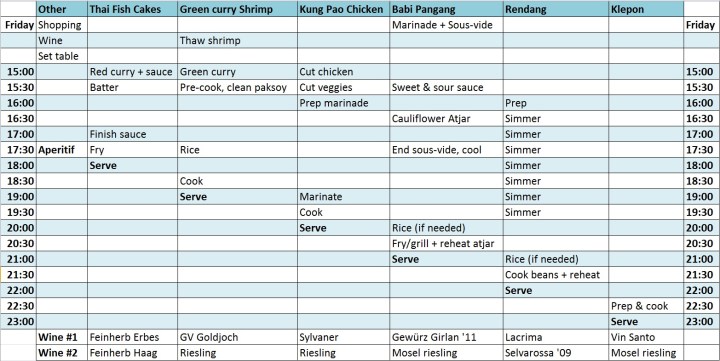






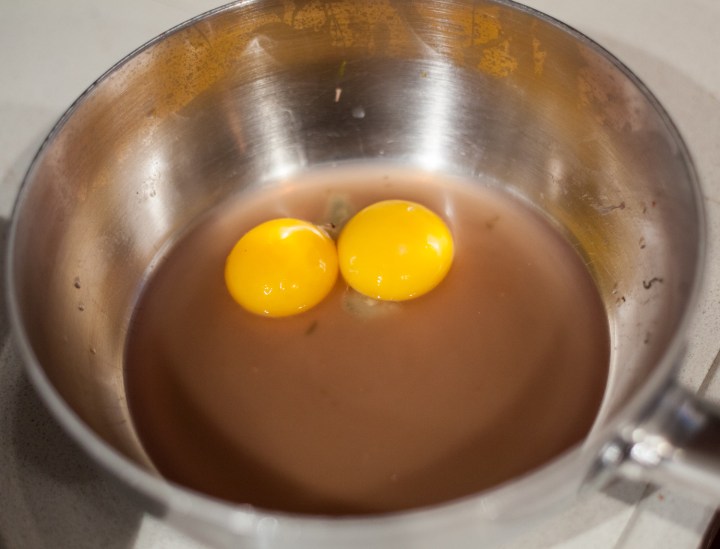




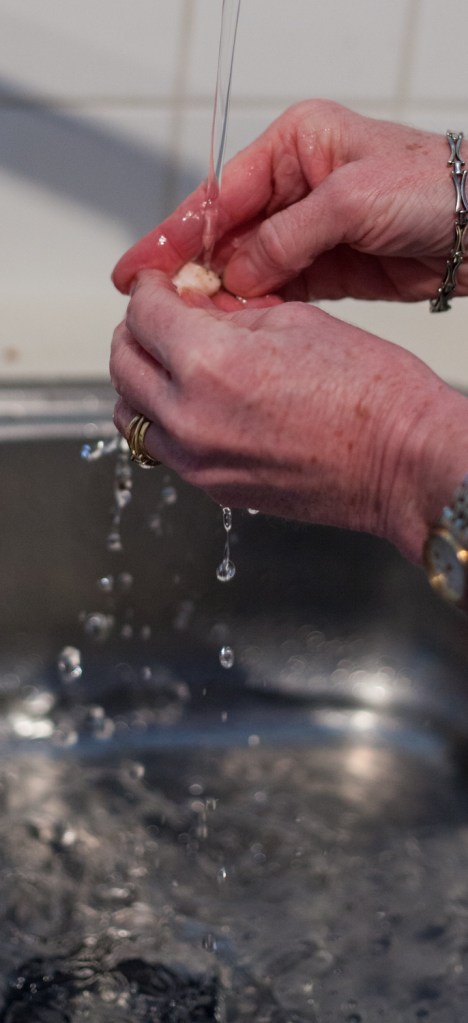










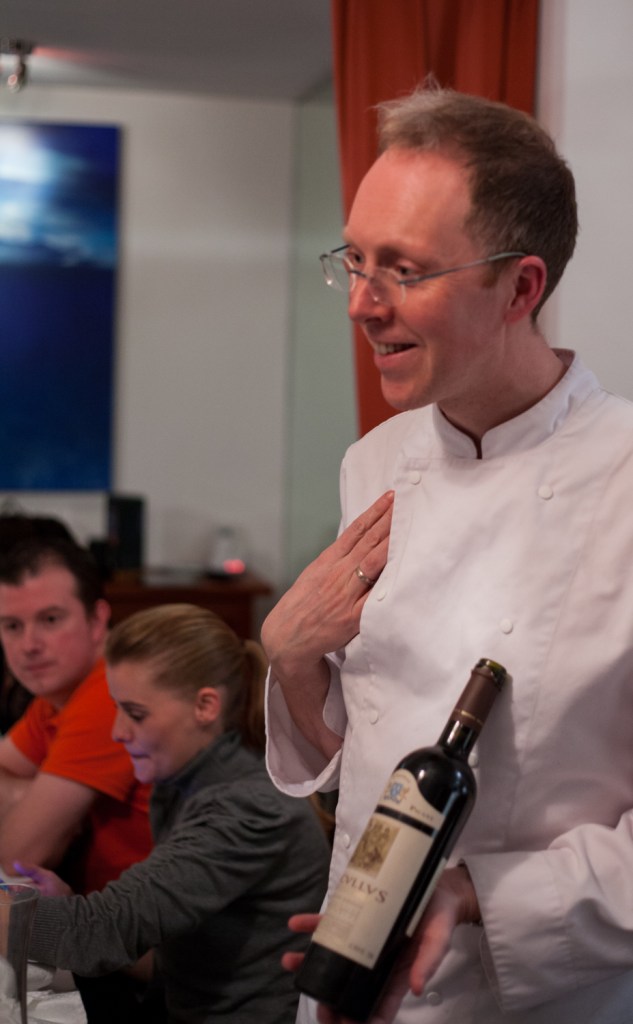




















Stephan, this post was wonderful to read and see. It was as sumptuous as any high toned cookbook I’ve seen. Beautiful job all the way around.
You should really write a book. Not just a cookbook, but a book of essays on Food with pictures and recipes and techniques.
I enjoyed this post immensely, can you tell?
LikeLiked by 1 person
Thank you so much!
LikeLike
You are simply amazing Stephan AND I sure wish I was your friend!! And I have no idea how you managed to have time to take photos whilst you were serving and cooking – and pouring!!! I agree – you should write a book !!
LikeLike
In fact I didn’t have time to take photos, Conor took care of that! When you are in the Netherlands in May or November, do check whether you can join one of these dinners.
LikeLike
I would sooo love to do that Stefan. I plan to sell my home here in Massachusetts (USA) and travel for a while. I will FOR SURE drop by to see you and, hopefully, I could be there when you’re having one of these dinners. (I’m good a washing dishes!!) ; o )
LikeLiked by 1 person
What a wonderful tutorial Stefan, you make it look so very easy!
LikeLiked by 1 person
A 303 dinner I have to visit from top down again! Yes, I use such ‘flow charts’ also: very relaxing as one ticks steps off and knows nought will be forgotten 🙂 ! But you are lucky to have so many friends passionate enough about food/wine to really get right into all the stages!
LikeLiked by 1 person
Stefan, I’m truly mesmerized by your love of food, wine, friends and blogging. You put such an incredible amount of work into prepping, cooking, selecting wines and then also serving and entertaining people for 6+ hours – wow! Incredible….
LikeLiked by 1 person
Thank you, Anatoli, it is indeed a work of love. You are welcome to join when you are in the neighborhood.
LikeLike
I have a lot to learn from you, Stefan, and not just about wine pairings. Getting your guests involved in the dinner’s financing and the actual dinner itself makes all of this possible. I’d love to sit in the kitchen and watch it all happen. Now that would be my kind of show. 🙂
LikeLiked by 1 person
To make that happen, you’ll just have to come visit 🙂
LikeLiked by 1 person
A truly gargantuan post Stefan. Brings back great memories. It was such fun.
LikeLiked by 1 person